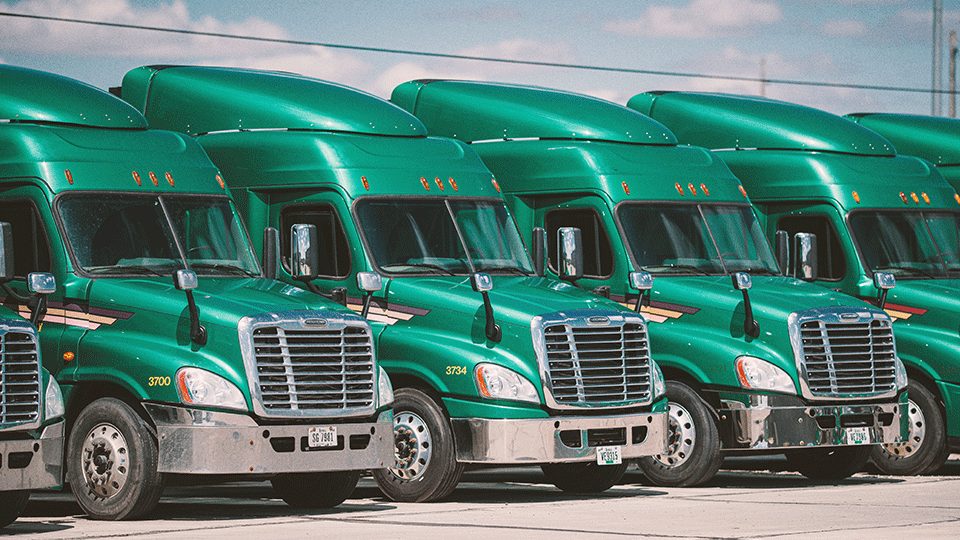
Composing a transportation network can take years of work. This is rarely a set-it-and-forget-it process. Your company’s supply chain is dynamic — with inbound and outbound freight volumes fluctuating periodically. Your network of transportation providers (freight brokers, asset carriers, 3PLs, etc.) should adjust to match these needs.
Since every company has unique service requirements, there isn’t an exact number of transportation providers a business “should” use. Your company probably uses more providers than some do and fewer than others. It’s your job to find a balanced mix of reliable carriers and then manage these relationships.
As needed, you host bids to collect quotes from viable transportation providers, asking them to submit their best rates for a specific number of shipments over a set period.
These requests for proposal (RFPs) are a great way to make volume commitments to your carriers and plan out your shipments over an upcoming business cycle. Locking in agreements with tested providers has plenty of benefits, making it a widely used tactic across supply chains.
While trusting the bulk of these shipments to familiar carriers is recommended, you may also want to take the opportunity to intermittently add new carriers to the mix during this time.
In the pursuit of a great supply chain, constant improvement and evaluation are important.
Adding a new provider mid-cycle — when the majority of your shipments are already covered — allows you to test out a potentially great company with (relatively) low stakes. If things go well, you’ll be on your way to developing a new partnership. If they miss the mark, you’ll be glad you made this discovery over the course of a single shipment (or two), instead of later on.
Anderson Trucking Service (ATS), has been operating as a commercial transportation company since 1955. Over this period, companies have repeatedly brought us on mid-cycle to handle intermittent shipments. In many cases, these relationships (which began on a trial basis) have flourished into long-term partnerships.
For this reason, you may want to consider adding a new provider mid-cycle as well. That said, there are also some downsides to adding a provider in the midst of your business cycle — these can be prohibitive in some instances.
To help you make this decision, this article will outline the pros and cons of bringing on someone new mid-cycle.
3 Advantages of Adding a New Provider Mid-Cycle
Generally speaking, there are three major advantages to adding a carrier to support your supply chain during a business cycle/project. Provided the company has good credentials, history and experience, introducing them at this point is a good idea for the following reasons:
- Allows you to test and develop a history with them
- Exposes the provider to your processes and procedures
- Helps you gain additional/fallback capacity when needed
1 | Allows You to Test and Develop History With Them
Creating a reliable, efficient supply chain hinges on your ability to understand each transportation company’s processes and trust their abilities. Developing this rapport with a new provider always takes time.
You can’t risk repeated failures during the initial stages of these relationships and onboarding a company mid-cycle softens this burden. Instead of diving headfirst into a new partnership, bringing someone on when the majority of your shipments are covered allows you to prolong this introductory period.
This way you can develop history and trust on your terms, test out their service, begin understanding their processes and make sure their structure supports you.
With this relationship in place, you can slowly increase (or maintain) the number of loads you give them, eventually using them as a full-fledged portion of your network.
In the end, this will make future RFPs easier since you have another partner to lean on.
2 | Exposes The Provider to Your Processes and Procedures
Bringing on a new carrier mid-cycle is a great way to develop trust and history on both sides. Kicking off a relationship with a few shipments helps familiarize transportation companies with your processes.
Exposing a provider to your supply chain, allowing them to see how you run things and to understand what’s expected of them every step of the way, is very valuable in the long run. These insights help transportation companies cater their services to your needs — something that can’t be done without exposure.

Additionally, provided this relationship progresses, bringing on a new carrier mid-cycle helps them submit accurate proposals down the line (since they have the right perceptions).
This can also expedite onboarding in the future as they’ve already serviced your company and know how things operate from start to finish.
3 | Helps You Gain Additional Capacity When Needed
Regardless of how well-organized your supply chain is, sometimes shipments come up unexpectedly or arrangements fall through. This is where onboarding a new carrier mid-cycle can come in handy.
Loads that aren’t allocated elsewhere — due to service failures or otherwise — can be handled by your extra provider. If nothing else, adding another provider mid-cycle gives you an option to fall back on should an issue occur. The last thing you need — especially during a peak period — is to have shipments fail because you ran out of capacity.
Adding another provider and tendering them loads on a spot-market basis as they arise will help you keep your supply chain on track.
3 Downsides of Adding a New Provider Mid-Cycle
At this point, you may be hesitant to bring on someone new — especially if your network is full of great transportation providers. While it’s always important to have additional options and to know when it’s time to switch providers, your concerns aren’t unfounded; sometimes adding a new provider doesn’t make sense.
Here are the three largest downsides of adding a new transportation provider mid-cycle. Keep these, along with the advantages, in mind while making this decision:
- Initially, onboarding may be inconvenient
- Risk of disrupting relationships with your current providers
- Risk of service disruptions
1 | Initially, Onboarding May Be Inconvenient
Onboarding a new transportation provider is always extra work. It’s up to you and your team to ensure a smooth transition for each company. This process should include introducing them to your procedures, setting expectations, establishing communication channels and answering questions.

It’s difficult to avoid this process — especially since your customers are counting on you to deliver on your commitments. As such, if you decide to add a new carrier mid-cycle, some of your time will be spent onboarding them. Although this onboarding might not be as thorough as it is with your higher-volume providers, it will exist nonetheless.
2 | Risk of Disrupting Relationships With Your Current Providers
The transportation industry — like many others — is competitive. Given the opportunity, most carriers will opt to provide you with as much capacity as you need.
And, when they’re awarded a set volume of loads per period (following an RFP), your core providers are relying on this commitment. For this reason, it’s important that bringing on another provider won’t disrupt these existing relationships. You won’t want to give shipments to a new carrier that were promised elsewhere (unless it’s necessary, of course).
Doing so could damage your relationship with existing providers, so you’ll want to be careful here; try to work a new provider in mid-cycle using excess shipments or for surge capacity requirements. This will help you avoid disrupting your current relationships.
3 | Risk of Service Disruptions
Every time you bring an untested transportation company into the fold, there’s a risk that they’ll be a poor fit. With so many transportation companies in the U.S., it’s difficult to select the best ones from the field.
Although bringing on a new provider mid-cycle lets you test their service on an interim basis, an unused provider — that’s unfamiliar with your cargo, business and procedures — presents a risk of failure.
Whenever you add to a new provider, it’s important to properly vet them for service history, infrastructure, safety, technology usage and expertise. Even if they check every box on paper, you never actually know until you try them. As such, you’re at risk of service disruptions which is definitely worth noting.

Is Now The Right Time to Add a New Provider?
Your job isn’t easy. That’s for sure. The right mix of transportation partnerships makes your duties a lot more manageable though. That’s why, in the right situation, adding a new provider mid-cycle can make a lot of sense; this allows you to test them on a trial basis, expose them to your processes, gain more capacity and expedite onboarding in the future.
On the other hand, bringing on a new company can be a hassle if you’re short on time and opens up the possibility of disrupting your current partnerships.
In the long run, however, these risks might be worth taking.
At the end of the day, your company deserves providers it can rely on; there is too much on the line to expect anything else.
That said, knowing when to cut a transportation company loose and move on can be difficult. When is enough, actually, enough? Is the grass really greener?
To help you make these discernments and avoid sticking with an underperforming carrier for longer than you need to, read this article which explains how to know it’s time to switch transportation providers. There are six leading indicators that it’s time to move on, make sure you recognize them.
Finally, here at ATS, we have a robust suite of transportation services created to help companies like yours deliver on their customer commitments. Check out our services page here. And, if you’d like to learn more about any of them (or are interested in adding us to your supply chain mid-cycle) don’t hesitate to contact us.




